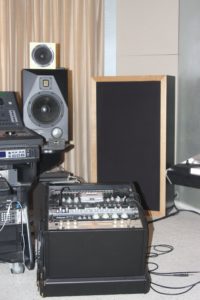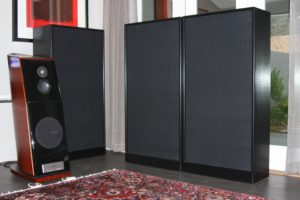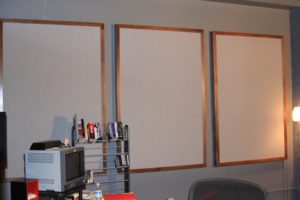If you boil all the complexities of room acoustic analysis down into two basic areas, you have sound pressure reflection issues created by energy below 200 Hz. and the reflections from all of the room boundary surfaces. Low frequency energy will simply not fit into our smaller rooms. When it doesn’t fit, it expresses its discontent by producing room modes. Reflections from our room boundary surfaces mixes with the direct or straight line sound from our speakers and adds room sound into our recordings thus, contaminating the recorded sound upon recording and playback.
Sound Pressure Reflection – Low Frequency Energy
Low frequency energy or energy below 200 cycles, has dimensions that do not usually fit into our smaller personal listening, home theater, or professional recording studios. If the dimension or length of the low frequency wavelength does not have enough physical distance to travel in our rooms without striking a room boundary surface, it will double back, striking another wall surface and begin to create pockets of excess energy called room modes. Room modes can either exaggerate or smother certain frequencies and their fundamentals.
“Bass Boom”
If a room modes exaggerate certain frequencies, then we have a phenomenon called “bass boom”. We have all heard this. It is low frequency energy congregating in certain room areas. This energy causes the air within that particular room area to vibrate until it produces a resonance. We usually hear this bass boom at frequencies below 100-200 cycles because these wavelengths tend to be longer in length and will not fit comfortably into certain room dimensions, especially today’s smaller rooms.
Wavelength Formula
To calculate the length of any wavelength, we use a simple formula. We take the speed of sound which is in round numbers 1,130′ / second and then divide that by the frequency we wish to know the wavelength of. If we take 40 Hz. as our frequency, we then divide the speed of sound which is 1,130′ / sec. by the 40. We get 28.25′ which is the length of a 40 Hz. wave. If our room is 16′ long, one can see that our 40 Hz. wavelength will not be able to complete a full cycle and run completely in length.
Physical Incompatibility
The physical length of lower wavelengths and the small rooms we produce them in are simply not compatible. Without enough room to run free, they act as caged animals and kick and punch their way into a room mode. Some of the lower frequency energy stays in our room, some goes through our room and into the next structure. It is the incompatibility of the length of the wave and the physical dimensions of our rooms that causes all the commotion and these pressure areas at the monitoring or mic position are definitely unwanted.
Comb Filtering
Comb filtering is another pressure issue that most small rooms deal with. If we take our speaker as our sound source and place it next to a wall, the energy generated by the speaker will strike the wall and then back to the speaker. This interplay of energy repeats itself until on a graph, we have a series of spikes which look the the individual teeth of a comb. Thus, the term comb filter.
Comb Filter Pressure
All of this back and forth movement of sound energy between the wall and speaker produces another pressure area that can hide other frequencies we wish to hear. The pressure created by a comb filter is not as great as a room mode but it can have the same impact on frequencies. It can smother and blur frequencies, especially middle frequencies where complete frequencies and their harmonics are available. Comb filters have a disastrous impact on our mid ranges where our vocals and all guitar sounds lie. This is the frequency range of all the emotion in our recordings.
Direct Energy
The direct energy from our loudspeakers is the energy that travels in a straight line from the speakers to our ears. A straight line is the shortest distance between two points and sound that travels from our speakers in a straight line to our ears is the purest of all sound and it represents the recording in the most accurate way. This is the main reason for near field monitoring. The engineer wishes to hear only the direct sound from his speakers, not any reflections from room boundary surfaces, so he sits closer in proximity to the wanted direct sound.
Multiple Radiation Patterns
Sound radiating from a speaker radiates out the front, sides, and when lower frequencies are addressed, even out of the rear of the speakers. This multi – directional radiation pattern produces energy that then strikes our room boundary surfaces. When it strikes our walls, ceiling, and floor, reflections are produced. These reflections then mix with our direct sound energy from our speakers and add to our signal “room sound”. Reflections are the sound produced by the room.
Wanted Reflections
Reflections are wanted in our home theaters and personal listening environments. They are not wanted in our mixes. Reflections produce a more realistic sense of sound in our rooms because we are very used to hearing reflections from surfaces that we live and work in. We drive to work in a “box” and live in a “box”, so in these environments reflected sound energy is the norm. Reflections help us in locating distance and position when it comes to our musical presentations.
Pressure And Reflections
Small room acoustics is all about low frequency pressure management and the taming or slowing in time of room boundary surface reflections from our side, front, and rear walls. Low frequency energy produces pressure areas termed room modes and reflections from our room’s boundary surfaces produce reflections that superimpose themselves upon the direct sound from our monitors or speakers. We must reduce low frequency sound pressure issues through the use of powerful absorbers and we can slow the energy from reflections down using absorption or diffusion technologies.










We use broadband absorption in the two most critical frequency regions in small rooms. Our Diaphragmatic absorbers, ACDA series, have…
Interesting web site and provocative introduction. Please check your copy for typos, otherwise nicely presented. I would like to see…
There is no such thing as soundproof anything especially carpet. Low frequency noise transmission requires a permanent construction fix with…
Hello Dennis! Our neighbors put a Ice Bath in their garage which is right below our bedroom and the Low…